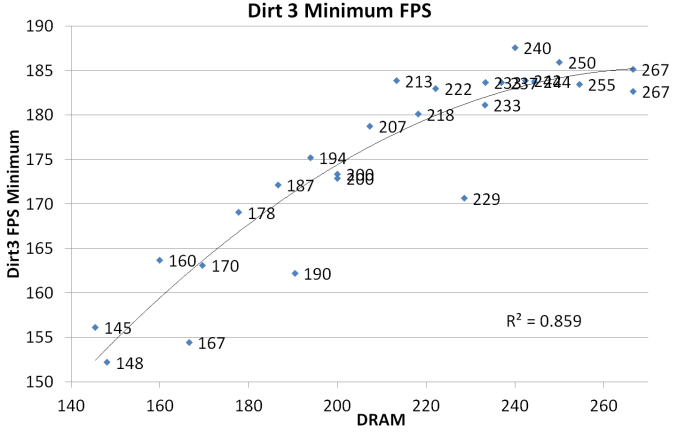ADATA XPG V2 Review: 2x8 GB at DDR3-2800 12-14-14 1.65 V
by Ian Cutress on December 17, 2013 12:00 PM ESTConclusions
The problem these high MHz specification kits have is like a see-saw. If it had the real-world performance in line with price increments for memory, it would justify itself in the cost – but instead we get an inflated price for no real world benefit. This is endemic to any DRAM manufacturer who bids on these high end Hynix ICs just to provide themselves with promotion material to say ‘we sell high MHz DDR3’. Ultimately the only benchmarks that show any benefit are synthetic tests, and any real world test that benefits from high end memory tends to reach limiting returns around DDR3-2400 C10. Only specific memory limited compute tasks benefit from the high end numbers. Even in Dirt 3 minimum frame rates, where we usually see the biggest difference in memory timings, the results are obvious:

In this graph the x-axis is the Performance Index of the DRAM, and thus a PI of 200 can be 1600 C8 or 2400 C12.
Back in our pricing analysis, we saw a big jump moving from 2666 MHz to 2800 MHz memory:
$205: G.Skill TridentX 2x8 GB 2666 C12
$230: Team Xtreem 2x8 GB 2666 C11
$270: G.Skill TridentX 2x8GB 2666 C11
$320: Corsair Dominator Platinum 2x8GB 2666 C11
$320: Corsair Dominator Platinum 2x8GB 2666 C12
$600: G.Skill TridentX 2x8GB 2800 C12
$646: ADATA XPG V2 2x8GB 2800 C12
$730: Corsair Vengeance Pro 2x8GB 2800 C12
$750: G.Skill TridentX 2x8GB 2933 C12
At C11/C12, these memory kits perform roughly the same, meaning that the +100% price difference ($320 -> $646) is essentially another midrange GPU (or half a GTX 780 Ti) worth of cost. For that reason alone, no DDR3-2800+ kit is ever going to be justified in cost.
I cannot fault ADATA on their product – DDR3-2800 C12 is as DDR3-2800 C12 does. It overclocks a relatively small amount, and it pairs high specifications with high density and thus high price for little performance gain in our testing suite. My conclusion is essentially the same as with the G.Skill DDR3-3000 C12 2x4GB kit we tested (which was around the same price as this 2x8GB kit):
“It is a high price for a kit that offers little apart from a number parade. Perhaps the thing to remember is that plenty of memory manufacturers are also aiming at high MHz – Corsair, Avexir, TeamGroup, Apacer and others. If I had that money to spend on a daily Haswell system, I might plump for 4x8GB of DDR3-2400 C10 and upgrade the GPU with money left over.”











19 Comments
View All Comments
YuLeven - Tuesday, December 17, 2013 - link
Thanks for the review.But with all due respect to this site that makes one of the best hardware coverage in English, I'm kind missing interesting stories lately. The late 2013 MacBook Pro, some Windows tablets, GPUs, CPUs, operate systems... anything.
As fat as real world performance is concerned, RAM impact is so negligible for the vast majority of users that this sort of article ends kinda of... boring.
Yet again, thank you for the article. I meant no offence in any way!
SeeManRun - Tuesday, December 17, 2013 - link
Definitely agree with this one...Zak - Tuesday, December 17, 2013 - link
I have to agree that these memory articles are uninteresting and not particularly useful. As others pointed out -- and these articles confirm -- the real life difference between decent DDR1600 and super-duper ultra-high-end RAM are virtually non-existent. One article summarizing that would be more than enough.jeffrey - Tuesday, December 17, 2013 - link
Ian Cutress,Hello again! This is another article stating 1866/C9 being the minimum for Haswell and to avoid 1600 or less. Even going so far as to say, "Any kit 1600 MHz or less is usually bad news."
However, this ignores 1600/C8 modules. The 1600/C8 score a 200 on your Performance Index at stock timings. This is at your recommended 200 level. There are several kits of 2x4 GB 1600/C8 on Newegg that have memory profiles of 8-8-8-24 at 1.5v. I'll repeat, these 1600 8-8-8-24 1.5v kits score 200 on the Performance Index and hit the current memory sweet spot for most people of 2x4 GB. This scores very close to the 1866/C9 kits which have a Performance Index score of 207.
The reason I bring this up is that the 1600 8-8-8-24 kits are often less expensive than the 1866/C9 kits and offer essentially all of the performance.
I enjoy reading your articles and appreciate how active you have been lately!
The_Assimilator - Tuesday, December 17, 2013 - link
This is why I am sticking with my DDR3-1600/CL7 memory until DDR4 hits mainstream. PI = 228 which is faster than 1866/CL9.jeffrey - Tuesday, December 17, 2013 - link
Ian, any comment on 1600/C7 or 1600/C8?Gigaplex - Tuesday, December 17, 2013 - link
"In this graph the x-axis is the Performance Index of the DRAM, and thus a PI of 200 can be 1600 C8 or 2400 C12."This article does not ignore 1600/C8 modules.
Popskalius - Sunday, February 23, 2014 - link
hi, i'm new to ddr3 lol. Re: haswell & 1600/C8, anandtech's intel gaming rig pairs an i5 with 1600/C9. Is this bc it's the cheapest build so not worth the price/performance, or is there really something bad about mixing haswell with anything slower than 1600/c8?thanks a bunch
Senti - Tuesday, December 17, 2013 - link
And another incompetent article from Ian... Didn't even bother to read comments to the previous one to correct errors...Oh, and my IP (range?) is still blacklisted by stupid spam filter. Of course, I probably not love my job enough...
AncientWisdom - Tuesday, December 17, 2013 - link
Lol maybe it should spam filter depending on the job happiness scale, seems legit.